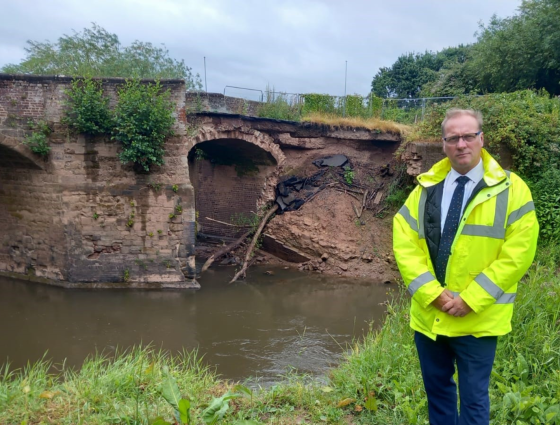One of the first stages in the long-term repair of Powick Old Bridge will begin later this Summer.
A temporary ramp will be installed from the footway into the river channel, and a working platform created on the upstream side of the river, Worcestershire County Council has confirmed.
The purpose of the working platform is to safeguard the collapsed area of the wingwall from further damage, and to allow the arch and abutment to be properly inspected.
Recognising the important historic nature and originality of the structure, it will also protect the damaged section from losing more material, and add support to the whole structure before the main repairs begin.
The temporary works will be followed by detailed design of a permanent reconstruction which will require further approvals ahead of final works next year.
The temporary platform will prevent water from entering the arch so that work can take place, and if the river does flood water will be diverted over the top of the platform.
This approach will also lead to a large proportion of the original stonework being reclaimed from the river bed. The wing wall will need to be completely taken down as part of the repair process, however, the rebuild will use as much of the initial stone and brick as possible.
Councillor Marc Bayliss, Worcestershire County Council’s Cabinet Member with Responsibility for Highways and Transport said: “We are extremely mindful of the significance of Powick Old bridge and are determined to treat it with the care and attention that such a key historic structure deserves. Hopefully the installation of the temporary platform will reassure people that we are working hard to reinstate the bridge to its former glory. The platform will protect the damaged section of the bridge from losing more material and prevent water from entering the arch so restoration work can take place.”
“We are working alongside partners, including the Environment Agency and Historic England, to ensure we are able to repair the bridge in a way that doesn’t compromise the look of the structure. There isn’t a quick fix, this restoration will take time and patience to ensure that all work is carried out with the consideration that such an important bridge deserves.”
It’s hoped that the arch can be saved due to its historical significance, however, to further understand the extent of the damage the arch will need to be supported.
This will require an additional temporary platform downstream of the river. There may be a need to build a steel A-Frame which will then allow the arch to be reinforced so that the bridge can be fully inspected to enable repairs to commence.
It has taken time to get to this point as originally access was limited due to flooding and since then, there has been substantial engagement with key partners.
This includes Natural England, as the structure is within a Site of Special Scientific Interest (SSSI), Historic England due to the important nature of the structure, the Environment Agency due to river impacts, as well as several specialist contractors. The design for the temporary works is as complicated as the permanent repair works.
A web content page is currently being established on the Worcestershire County Council’s website so people can understand more about the history, understand the process of the reinstatement and follow progress.

 Facebook
Facebook X
X Email
Email WhatsApp
WhatsApp Messenger
Messenger